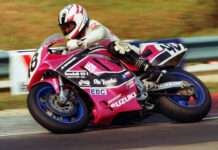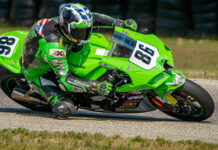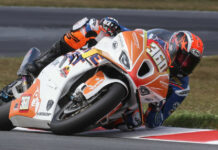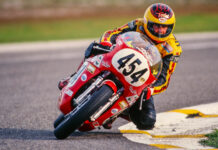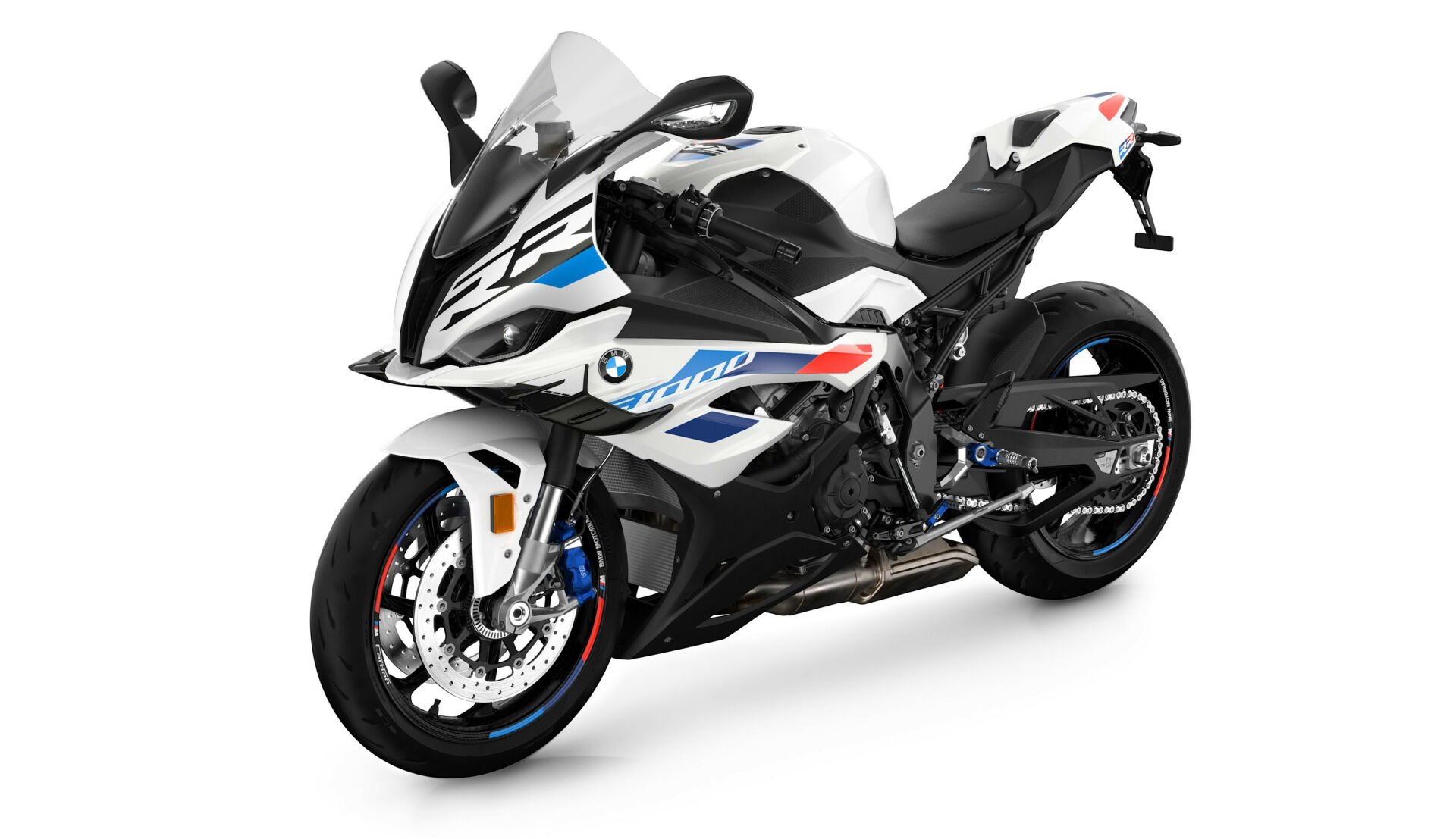The 2023 BMW S 1000 RR
Updated chassis, suspension and aerodynamics.
New electronic assist features.
MSRP of $17,895
Expected U.S. market arrival – January 2023.
Woodcliff Lake, NJ – September 29, 2022…BMW Motorrad USA is proud to announce the new, updated, 2023 BMW S 1000 RR with meaningful enhancements to the chassis, suspension, aerodynamics and electronic assist systems. First introduced in 2009, the BMW S 1000 RR has become the standard for its segment in terms of performance and rider safety features.
“With an advanced suspension and chassis, the new Brake Slide Assist and DTC Slide Control assistance systems as well as optimized aerodynamics with winglets and a redesigned rear end, we are able to raise the RR’s performance to a new level.” Wolfgang Wallner, Project Manager S 1000 RR
The highlights of the new BMW S 1000 RR
Shorter secondary gear ratio for more traction at the rear wheel.
Advanced “Flex Frame” with more flex.
Chassis geometry with new steering head angle, offset, caster and wheelbase.
M Chassis Kit with adjustable swinging arm pivot point and raised rear end.
Dynamic Traction Control DTC with new Slide Control function for drifts while accelerating using steering angle sensor.
ABS Pro with new Brake Slide Assist function using steering angle sensor for braking drifts when approaching corners.
ABS Pro Setting “Slick”
Optimized aerodynamics with new front section, winglets, high windshield and partitioning off of the lower triple clamp.
M lightweight battery as standard.
USB charging port in the rear section.
Redesigned rear section and shorter license plate holder.
Redesigned wiring harness for easier removal of the license plate frame.
Clutch and generator cover in black.
Easier rear wheel assembly removal due to loss-proof axle bushings, chamfered brake pads and brake anchor plate.
M GPS Mouse Adapter as part of the BMW Motorrad original accessory range.
New GoPro holder as part of the BMW Motorrad original accessory range.
Three paintwork finishes: Blackstorm metallic, Style Passion in Racing Red non-metallic and Lightwhite non-metallic/BMW M.
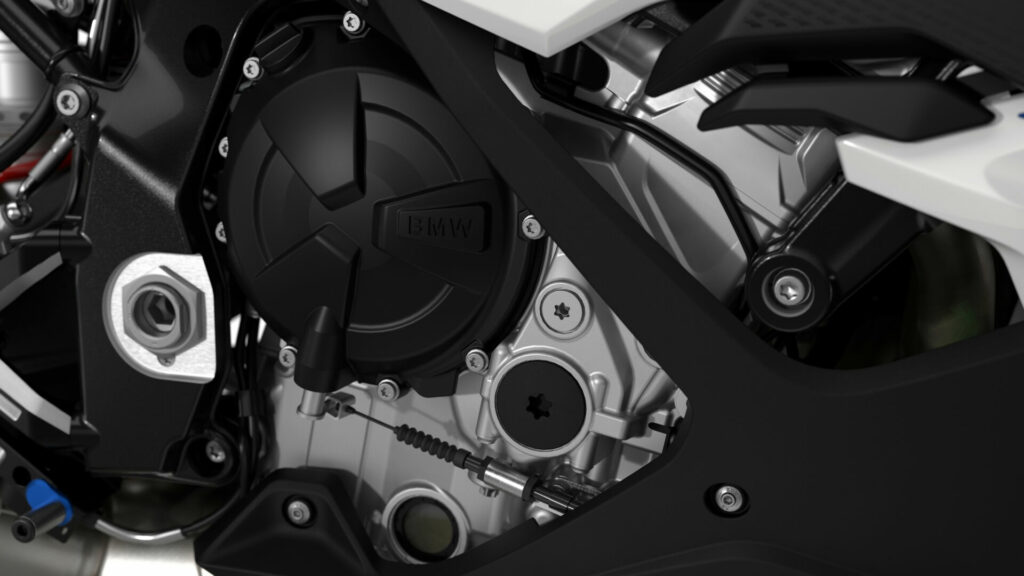
Engine and drivetrain
The new RR features a revised 4-cylinder in-line engine and delivers 205 hp at 13,000 rpm and a maximum torque of 83 lb-ft. at 11,000 rpm, unchanged in the U.S. from the outgoing model’s power and torque figures. The maximum engine speed is 14,600 rpm. Increased rear wheel traction in all gears is provided by a shorter secondary gear ratio through the use of a sprocket with 46 instead of 45 teeth.
The cylinder head with new intake port geometry is modelled on the M RR engine. With the aim of achieving optimum power delivery across the entire rev range, the intake ducts have been redesigned as well. They feature the advanced channel geometry as used in the M RR but have a cast surface instead of milled as on the M RR.
BMW ShiftCam Technology
The advanced RR engine is equipped with BMW ShiftCam Technology for varying the valve timing and the valve stroke on the intake side. This is a three-part intake shift camshaft that has two cams mounted on a shift segment for each valve to be actuated: a torque cam and a power cam, each with optimally designed cam geometry. The shift speed of the BMW ShiftCam of the new RR is 9,000 rpm, same as before.
By means of an axial displacement of the cam segment, the inlet valves are shifted from either the torque cam or the power cam in just 10 milliseconds, depending on the load and speed. The axial displacement of the cam segment and thus the use of torque or power cam is affected via two shift cams on the cam segment and two electromechanical actuators. The different design of the cam geometry is used to vary the timing and the valve lift. While the full-load cam provides maximum valve lift, the partial-load cam delivers reduced valve lift.
The benefits of BMW ShiftCam Technology include:
Increased torque in the low and medium speed range while preserving peak output.
Optimum design of partial-load cam geometry for the low to medium load and engine speed range.
Reduced load change loss in the partial load range.
Reduced exhaust emissions and optimized sound.
Improved Airbox
The new RR powerplant is equipped with a new airbox with variable intake funnels. The intake funnels have been shortened, as found in the M RR engine, in order to optimize the air charge and thus power generation, especially at higher engine speeds.
As before, the length of the intake funnels is varied in two stages via a map-controlled servomotor mounted on the airbox. The shorter intake passages are opened from 11,900 rpm since these are more favorable in terms of achieving maximum output.
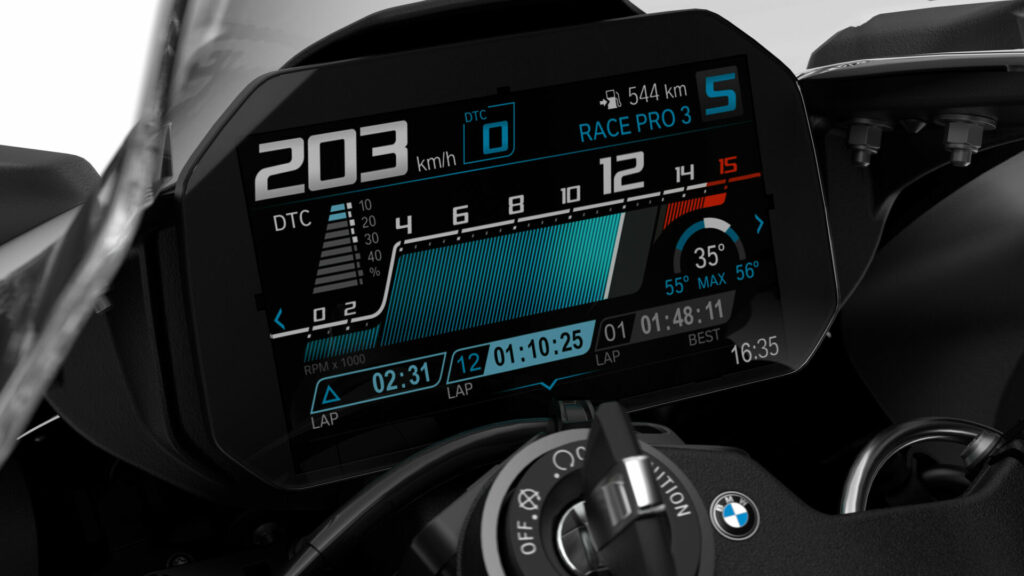
Ride modes and Dynamic Traction Control (DTC) with new Slide Control
The 2023 BMW S 1000 RR features two distinct sets of riding modes: For street and for the track. The four standard modes include “Rain”, “Road”, “Dynamic” and “Race”, while the optional “Pro Modes” offers “Race Pro 1”, “Race Pro 2” and “Race Pro 3”. The latest generation of Dynamic Traction Control (DTC) with 6-axis sensor cluster, lean angle sensor and fine adjustment for even more safety and performance when accelerating are also standard.
The new feature of Dynamic Traction Control DTC is the Slide Control function. The central component of Slide Control is the steering angle sensor. Based on its signal, together with the wheel speeds and the sensor box signals, the slip angle at the rear wheel (“drift angle”) is estimated.
Depending on the characteristics of the rear tire, the road surface and the drive slip allowed by the slip control, a slip angle is established. This is so small in the stable driving condition that it is not noticed by the rider. Slide Control compares the current slip angle and comes up with a set value dependent on the DTC setpoint. If it looks as if this setpoint is going to be exceeded, Slide Control initiates a reduction of the drive slip.
When slick tires are used on the track, the rider is assisted in controlling power slides that occur in combination with the appropriate riding style and DTC setting. For this purpose, the new RR has two different settings with separately stored drift angles: DTC settings 3 and 2. These enable very experienced riders to make the best possible use of the rear tire’s potential and to influence the bike’s racing line at the exit of the bend by using the throttle grip and the “drift angle”. Analogous to this new Slide Control function, the steering angle sensor makes it possible to use the new Brake Slide Control function.
As before, the DTC has four fixed basic settings for the respective riding modes “Rain”, “Road”, “Dynamic” and “Race”. In the “Race Pro” riding modes, fine adjustment (+/- Shift) is also available. The “Pro Modes” option offers an adjustable DTC Wheelie function for the first time. It allows wheelies to be suppressed or limited with the aim of achieving maximum acceleration via front wheel lift-off detection.
Throttle mapping
The new RR features two standard throttle maps which are linked to the riding modes “Rain”, “Road”, “Dynamic” and “Race”.
Rain: soft throttle response, reduced drive torque in the lower gears.
Road: optimal throttle response, reduced drive torque in the lower gears.
Dynamic: optimal throttle response, reduced drive torque in the lower gears.
Optimum throttle response, maximum drive torque in all gears.
In Race Pro 1 to 3 mode, the rider can select two additional combinations of throttle response and drive torque.
Smooth throttle response and full drive torque.
Direct throttle response and full drive torque.
As another element of the “Pro Modes” option, Engine Brake also offers a three-stage adjustment of engine drag torque during coasting.
Hill Start Control and Hill Start Control Pro
The new RR offers standard Hill Start Control to facilitate starting on gradients. The optional Hill Start Control Pro goes beyond Hill Start Control by providing the additional function Auto HSC. The settings menu allows this additional function to be individualized in such a way that the brake is automatically activated on a gradient (greater than +/- 5 %) when the hand or foot brake lever has been activated, shortly after the motorcycle comes to a standstill.
Advanced Shift Assistant Pro
As before Shift Assistant Pro enables upshifting without clutch actuation and thus offers acceleration almost without interrupting traction. It also allows downshifting without clutch or throttle actuation in the load and speed ranges relevant for riding. This allows very fast gear changes and reduces clutch use to a minimum.
For use in the new RR, the Shift Assistant Pro has been improved. The rider’s shift request is now implemented via a torque model and thus enables shifts in all operating ranges. At the same time, the reaction time to so-called claw or jaw hits has been optimized and the load change damping after gear changes has been improved. For use on the track, the conventional shifting pattern (first gear down) can be changed in a few simple steps to first gear up.
Launch Control
The new RR also offers the rider Launch Control for active support on race starts. Activation is done during standstill with the engine idling by pressing the start button for more than three seconds. The relevant information is displayed on the instrument cluster. From the technical point of view, Launch Control also limits engine torque so that the maximum transferable drive torque is available at the rear wheel when setting off in first gear. When the rider shifts into second gear, the engine torque is corrected in line with the change in ratio so that the maximum transferable drive torque continues to be available at the rear wheel during this phase.
Pit Lane Limiter
The Pit Lane Limiter enables the RR rider to limit speed when passing through the pit lane, regardless of the riding mode. The pit lane limiter is audibly perceptible and thus increases safety in the pit lane.
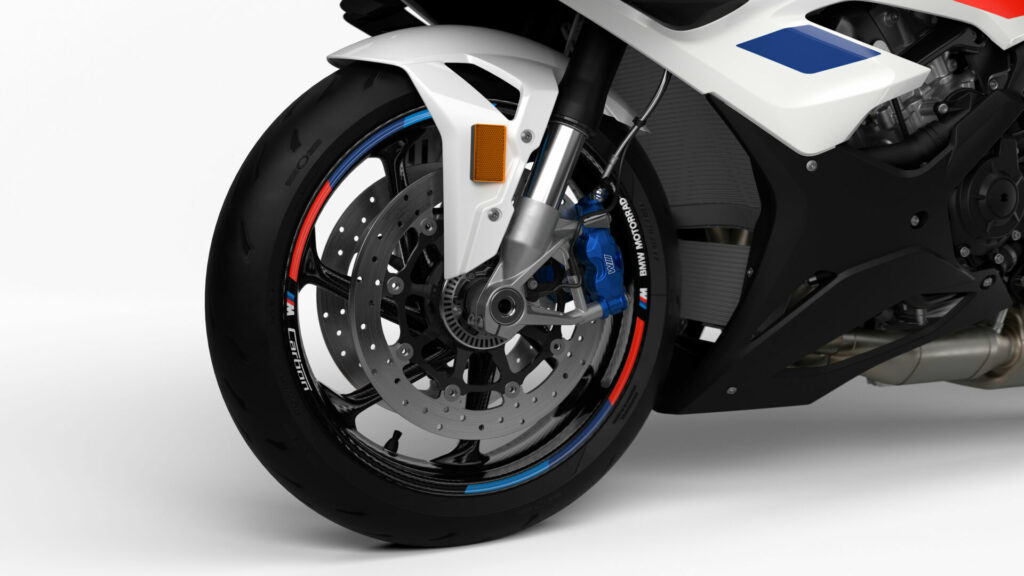
Suspension
“Thanks to the further developed Flex Frame as well as the new chassis geometry, the new RR offers even better riding precision, accuracy and feedback from the front wheel.” Sebastian Epp, Project Engineer Chassis
The RR was not only improved in terms of overall performance, but also with regard to the chassis and suspension. A revised main frame, modified chassis geometry as well as the new Brake Slide Assist system and the additional “Slick” ABS Pro Setting contribute significantly to the increased performance of the chassis and suspension.
Advanced “Flex Frame”
The heart of the chassis of the new RR is still the aluminum bridge frame, which is a welded construction of four gravity die-cast parts and integrates the engine, which is inclined forward by 32 degrees as before, as a supporting element. With the aim of optimizing lateral flexibility, the main frame of the new RR was given several openings in the side areas.
What has remained are the advantages of the frame due to its very narrow design. This significantly reduces the width of the bike in the area that is relevant for good knee contact, and it was possible to make the RR only about 0.8 inches wider than a V4 engine in this area. The rider benefits from being able to keep their thighs together closer to the bike and thus in a more relaxed riding posture.
Improved Chassis Geometry
Focus was also given to increasing riding precision when developing the new chassis of the RR. The steering head angle has been flattened out by 0.5 degrees (23.6 degrees instead of the previous 23.1 degrees and the offset of the triple clamps has been reduced by 0.1 inches. The castor was increased from 3.7 inches to 3.9 inches. At the same time, the wheelbase was extended to 57.4 inches, an increase of 0.7 inches. The adjustability of the swing arm pivot point and the height of the rear end is due to the use of the standard M Chassis Kit which allows for chassis geometric adjustments on the track. The new chassis geometry is accompanied not only by better riding precision, but also by increased accuracy and improved feedback from the front wheel.
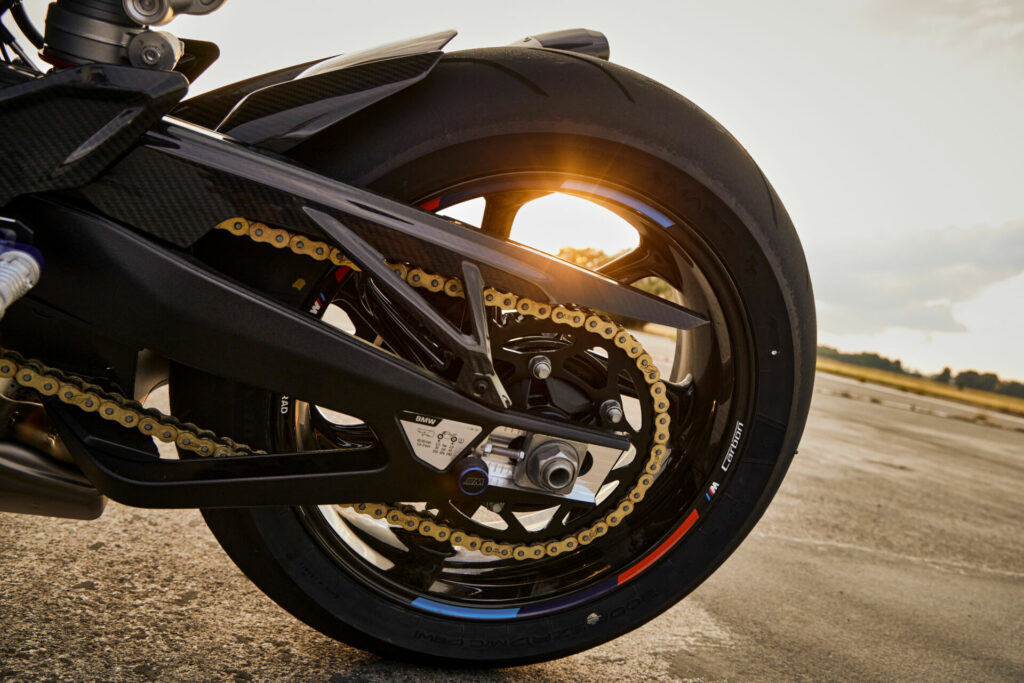
Easier removal of rear wheel
As before, rear wheel control is ensured by a gravity die cast swing arm derived from racing. Suspension and damping is provided by a central spring and shock with adjustable spring base, damping, rebound and compression. The rebound and compression can still be adjusted by means of a ten-click scaling. The shock is now height-adjustable for enhanced tuning. For easier removal and installation of the rear wheel, the axle bushings on the rear wheel on the right side are now mounted to prevent loss and the brake pads and the brake anchor plate are chamfered. The total rear suspension travel is 4.6 inches.
Fully adjustable upside-down 45 mm telescopic fork
As in the predecessor model, the upside-down fork with 45 mm slide tubes offers a high degree of brake stability, as well as a stable response and feedback.
The upside-down fork is fitted with closed-cartridge inserts, i.e. separate hydraulic piston-cylinder systems, and is fitted with adjustment options for the spring rest as well as the damping rebound and compression stage. The total front suspension travel is 4.7 inches.
Dynamic Damping Control DDC
The new version of the legendary RR can be equipped with an optional electronically controlled Dynamic Damping Control DDC suspension.
The basic settings of the DDC are linked to the riding modes “Rain”, “Road”, “Dynamic” and “Race”. In “Rain” and “Road” mode, the DDC’s tuning focus is on damping which can be best described as sporty-comfortable. “Road” is tuned for urban environments with poor to good asphalt surfaces.
The “Dynamic” riding mode, on the other hand, is intended for smooth road surfaces.
In the “Race” riding mode, the basic damping is increased for track use.
In the “Race Pro” riding modes, the individually adjustable “Race” DDC damping characteristic optimally supports track riding and provides an even firmer shock setting over “Race.” Here, the springs and shocks provide the rider with optimum and exacting feedback at all times with regard to the respective riding situation.
In addition, suspension tuning can be individualized in all riding modes. In the same way as with the mechanical adjustments, the customer can make the suspension softer or firmer simply by clicking in the configuration menu.
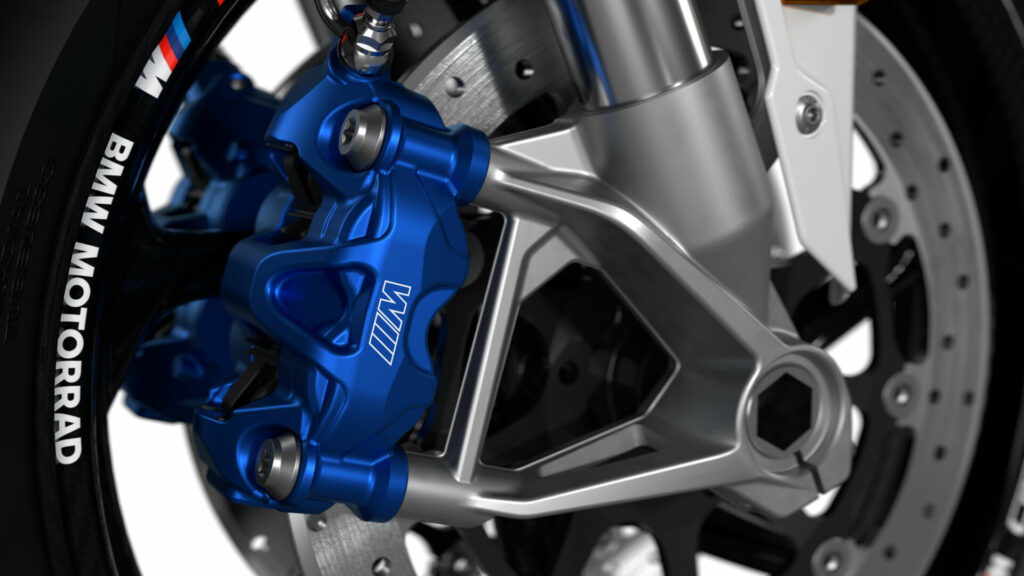
ABS Pro with new Brake Slide Assist and ABS Pro “Slick” setting
Like its predecessor, the new RR has a brake system that is supremely effective on the road and on the track. At the front there are two radially mounted 4-piston fixed calipers in conjunction with 320 mm / 12.6-inch steel brake discs which are 4.5 mm / 0.18 inches thick (5.5 mm / 0.22 inches thick with forged and carbon fiber wheels). At the rear, deceleration is taken care of by a single-piston floating caliper with a 220 mm / 8.7-inch steel brake disc.
ABS Pro is standard on the new BMW S 1000 RR. In contrast to conventional ABS systems, ABS Pro offers extra safety when braking in turns. Even when braking hard in a leaning position, ABS Pro is able to prevent the wheels from locking, thereby reducing the risk of falling when leaning – even in the event of panic braking. In the “Race Pro” modes, the ABS function can be set to five different levels, with the ABS Pro function linked accordingly. A new feature of the current RR is the ABS Pro Setting “Slick” as part of the optional Ride Modes Pro. This setting adjusts for the use of slick track tires.
The new Brake Slide Assist function is an important and very helpful innovation for track riders. As in the new DTC Slide Control function, this new system is based on steering angle sensors and allows the rider to set a specific drift angle for so-called braking drifts while sliding into corners at a maintained speed.
From a technical point of view, a slip angle (drift angle) is set using the steering angle sensor response by limiting the brake pressure at the rear wheel by the ABS Pro system and by controlling the rear wheel slip by the engine drag torque control (MSR).
Due to their position on the motorcycle and the application of force via the handlebars, the rider has considerable influence on the drift behavior during braking. Brake Slide Assist provides support to the rider for this partially unstable riding condition of drifting.
As a component of the “Pro Modes” option, DBC Dynamic Brake Control provides the rider with additional support during braking. DBC increases safety when braking, even in difficult situations, by avoiding unintentional throttle activation. As soon as the sensor cluster supplies a certain deceleration value during braking, any simultaneous desire to accelerate on the part of the rider is detected as implausible and throttle valve opening is suppressed. This keeps the motorcycle stable and shortens the braking distance.
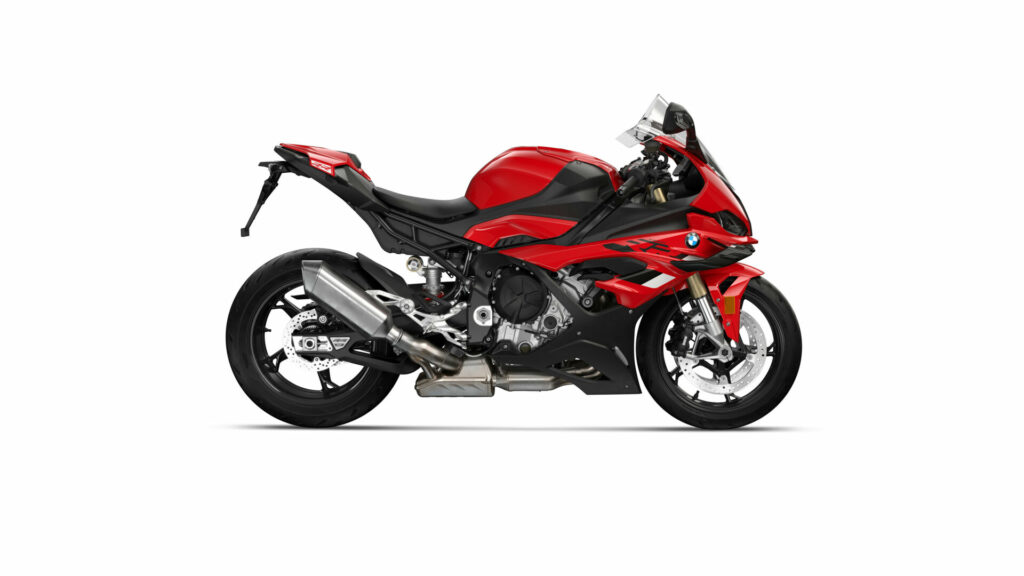
Electronic Systems
The 6.5-inch TFT instrument cluster of the new RR has four available screen layouts (Pure Ride with the main details and 3 Core screens) and riders can choose what is displayed to suit their needs as before.
As a new comfort function, the last selected screen display appears after turning on the ignition again. The entire display is designed with a focus on sport riding and its breadth of information, display quality and, last but not least, user-friendliness are still unrivalled in the supersports segment.
In addition to a wide range of functions and information, the BMW Motorrad developers placed particular emphasis on the best possible readability of the 6.5-inch TFT display. It is linked to the Multi Controller on the left-hand handlebar panel and can be operated quickly, safely and conveniently from here.
The rider can choose between customized screen displays for various purposes. The Pure Ride screen, for example, provides all the necessary information for normal operation on the road, while the three Core screen displays are designed for the track and provide a corresponding range of information. In addition, the rev counter is displayed here both in analogue form (Core 1 and 2) and in the form of a bar graph (Core 3).
In the course of the development of the RR, several new functions were added. For example, the new instrument cluster features an optimized display of the rev counter. It now has a dashed area and a solid red area that is directly controlled by the engine control unit. The dashed area is to be avoided in continuous operation, but can be approached briefly, whereas the continuous red area is blocked. This new display scheme applies, for example, to a reduced warm-up rpm limit, speed limitation due to diagnosed faults, Launch Control or when the engine is not yet at operating temperature. Another new function of the rev counter is that it flashes together with the shift light.
Further new functions of the instrument cluster are preselection of a riding mode as well as navigation and entertainment as part of “Driving Modes Pro”.
Alongside the digital display of speed, revolutions per minute, selected mode, settings for ABS Pro, DTC and DDC and the menus, it is also possible to access the following wide range of information on the screen (depending on the options fitted), for example:
Current left/right lean angle.
Maximum left/right lean angle.
Current deceleration achieved in m/s2.
Maximum deceleration achieved in m/s2.
Torque reduction through DTC.
Speed warning (display “SPEED” if a predefined speed is exceeded).
Average speed.
Average fuel consumption.
Trip 1 and 2.
Odometer.
Fuel level.
Remaining range.
For riders using their new RR on the track, the new instrument cluster offers additional and highly usable data which can be accessed in a variety of screen display formats:
Lap time and lap distance.
Lap specific speeds (min, max, average).
Active riding mode per lap.
DTC setting value per lap.
Lean angle left/right.
Lean angle maximums left/right per lap.
Maximum DTC torque reduction per lap.
Maximum deceleration per lap.
Number of gear shifts per lap.
Average throttle grip position per lap.
Total laps, total riding time and total distance.
Best-ever lap time.
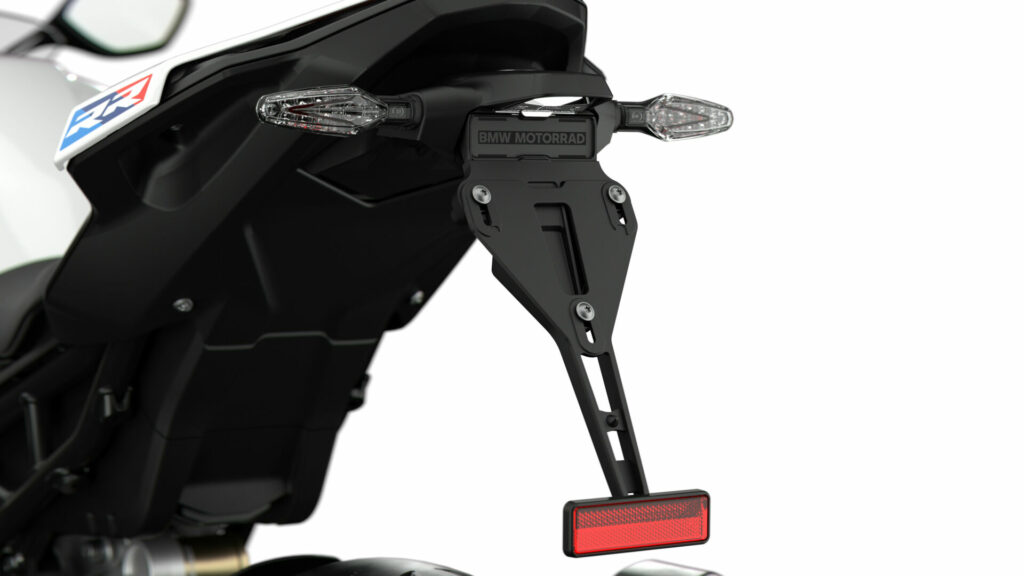
Quicker removal of license plate bracket, M battery and USB charging socket
As before, the license plate bracket, the turn signals and license plate lights form one unit and the functions of the brake and taillights are integrated into the turn signals. The extremely compact grouping makes it easy to get the RR ready for track use in a few simple steps. Thanks to a modified wiring harness, which is now equipped with an LWS connector, disassembly is now even quicker and easier.
Compared to the predecessor model, the standard equipment has also been expanded to include the previous optional extras – A lightweight M battery and a USB charging socket.
Aerodynamics and Design
“With the winglets, we were able to achieve an optimum balance of downforce and drag and thus improve the RR’s performance once again.” Johann Sievers-Paulsen, Body Development S 1000 RR
When it was launched in 2009, the RR immediately stood out thanks to its extremely compact layout and super-sporty design. This has not changed, and the new RR delivers a perfect harmony of super-sporty design, every-day usability and focused track use.
A newly designed rear section with pillion cover make the current RR look even sportier. The shorter license plate bracket is new as is the Endurance seat, which is available as part of the original BMW Motorrad accessory range. The rear pillion cover is available as an optional extra for the pillion seat.
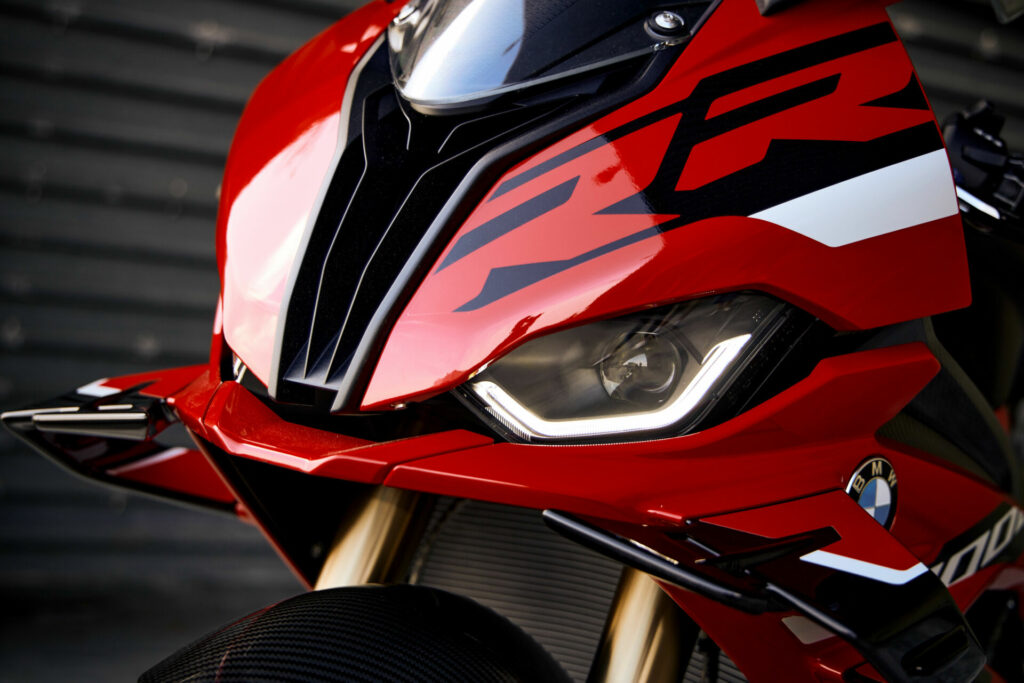
Winglets
One of the main areas of focus in the development of the RR was aerodynamics. This area has played a central role in both MotoGP and in the Superbike World Championship for several years now, with the aim of improving lap times even further. While for decades the developers of racing motorcycles concentrated almost exclusively on aerodynamic resistance (“drag”) and thus essentially on the best achievable top speed, today the focus is on other aerodynamic aspects for Superbikes and MotoGP bikes with outputs of well over 200 hp.
In addition to achieving the highest possible maximum speed, which is absolutely necessary for race victories, another goal, especially with these extremely powerful machines, is to achieve the best possible contact between the tires and the road – especially during acceleration.
Wheelies are absolutely undesirable from a racing dynamics point of view, as the drive force in a wheelie is not converted 100 percent into forward propulsion but into the rising of the front end of the motorbike. Accordingly, the traction control kicks in to prevent wheelies and thus maximize the forward driving force. Valuable tenths of a second are saved here.
The winglets on the front fairing of the new RR take this scenario into account as they generate up to 22 lbs. of aerodynamic downforce and thus an additional front wheel load depending on the speed. The additional wheel load on the front wheel counteracts the wheelie tendency during acceleration, thus the traction control system has to regulate less, making more drive power available for acceleration and leading to improved lap times.
The BMW Motorrad developers countered the slightly increased aerodynamic resistance caused by the small additional frontal area and shape of the winglets with a newly designed high windshield. This helps improve the flow around the rider’s helmet. A further aerodynamic improvement was achieved by partitioning off the lower triple clamp.
The dynamic design of the RR featuring a color scheme with three individual characters: The basic variants of Blackstorm metallic, Style Passion in Racing Red non-metallic and the racing-oriented Lightwhite non-metallic/BMW M. The now black covers for the alternator and clutch are featured in all three paintwork finishes.
Option Packages
M Package – Lightwhite paint with M lettering and new clear coat, M footrests, black fuel filler cap, M Carbon wheels, M sports seat. As an alternative to the M Carbon wheels, the customer can also choose the M forged wheels.
Dynamic Package – Ride modes Pro, DDC Dynamic Damping Control, heated grips, cruise control.
Race Package – M Endurance chain with M titanium sports silencer or M full titanium exhaust system.
Carbon Package – M Carbon front wheel fender, M Carbon rear wheel mudguard, M Carbon chain guard, M Carbon side trim, M Carbon sprocket cover.
Milled Parts Package – M folding clutch lever, M brake lever guard.
Individual Options
Alarm system
Pillion seat cover
RDC tire pressure monitor
M Performance Parts.
M axle protectors.
M Carbon airbox cover.
M Carbon rear wheel.
M Carbon front wheel.
M Carbon chain guard.
M Carbon rear wheel cover.
M Carbon front wheel cover.
M Carbon sprocket cover.
M Carbon fuel tank trim.
M Carbon fairing side panel top.
M Datalogger.
M GPS Lap Trigger.
M rider footrests.
M rider footrest system.
M seat.
M seat high.
M seat low.
M passenger footrests.
M folding handbrake lever.
M folding handbrake lever with remote adjustment.
M handbrake lever protector.
M chain tensioner.
M folding clutch lever.
M clutch lever protector.
M lithium-ion battery.
M rear assembly stand mounting spools.
M engine protectors.
M oil fill cap.
M cover kit.
M fork clamp for stub handlebars.
M forged wheel, rear.
M forged wheel, front.
M Endurance seat.
M tire warmers.
Storage
Folding rucksack.
Rear bag, 20-liter.
Tank bag, 1.5-liter.
Pouch for smartphone.
Tank bag, 10-liter.
Bag for passenger seat, 10-liter.
Ergonomics and comfort
Passenger seat.
Windscreen tinted.
Windshield, high.
Windshield, high, tinted.
Action camera/accessory mount.
Protection
Tank pad.
Radiator and oil cooler guard.
Protective film for TFT display.
Specifications
| BMW S 1000 RR | ||
| Engine | Liquid-cooled inline 4-cylinder | |
| Capacity | cc | 999 |
| Bore x stroke | mm | 80.0 x 49.7 |
| Power | hp | 205 @ 13,000 rpm |
| Torque | lb-ft. | 83 @ 11,000 rpm |
| Max. engine speed | rpm | 14,600 |
| Compression ratio | 13.3:1 | |
| Fuel | Power rated at 98 RON. 95-98 RON knock control | |
| Valvetrain | DOHC, valve actuation via single cam followers BMW ShiftCam variable intake cam control |
|
| Valves per cylinder | 4 | |
| Intake / Exhaust valve diameter | mm | 33.5 / 27.2 |
| Throttle body diameter | mm | 48 |
| Engine control | BMS-0 | |
| Emission control | Closed-loop three-way catalytic converter | |
| Alternator | watts | 450 |
| Battery | Volta / Ah | M lightweight battery 12v / 5 Ah |
| Headlamp | LED free-form twin low-beam, LED free-form high-beam | |
| Starter | kW | 0.8 |
| Clutch | Self-reinforcing multi-plate anti-hopping oil bath clutch, mechanically operated |
|
| Gearbox | 6-speed, constant-mesh | |
| Primary ratio | 1.652 | |
| Transmission gear ratios I | 2.647 | |
| II | 2.091 | |
| III | 1.727 | |
| IV | 1.500 | |
| V | 1.360 | |
| VI | 1.261 | |
| Secondary ratio | 2.706 | |
| Rear wheel drive type | Chain | |
| Frame construction type | Aluminum composite bridge frame, engine self-supporting | |
| Front suspension | Upside-down telescopic fork, 45 mm slide tube diameter Spring preload, rebound and compression adjustable Optional DDC electronically adjustable damping |
|
| Rear suspension | Aluminum underslung double-sided swingarm Central spring and shock absorber Spring preload, rebound and compression adjustable Optional DDC electronically adjustable damping |
|
| Suspension travel front / rear | inches | 4.7 / 4.6 |
| Wheel castor | inches | 3.9 |
| Steering head angle | degrees | 23.6 |
| Brakes, front | Twin 320 mm / 12.6-inch floating disks 4-piston fixed calipers |
|
| Brakes, rear | Single 220 mm / 8.7-inch, single-piston floating caliper | |
| ABS | BMW Motorrad ABS Pro, partially integral, disengageable | |
| Traction control | BMW Motorrad DTC | |
| Wheels | Standard die-cast aluminum wheels Optional M forged aluminum or M Carbon wheels |
|
| Wheels, front / rear | inches | 3.50 x 17 / 6.00 x 17 |
| Tires, front / rear | 120/70 ZR17 / 190/55 ZR17 | |
| Length x width at mirrors | inches | 81.6 x 33.3 |
| Wheelbase | inches | 57.4 |
| Seat height | inches | 32.4 |
| Weight, DIN unladen, fully fueled | lbs. | 434.3 standard trim, 430.8 with Race Package 426.6 with M Package |
| Permitted total weight | lbs. | 897 |
| Fuel tank capacity | gallons | 4.4 |
| Acceleration, 0-62 mph | seconds | 3.2 |
| Top speed | mph | 186+ |
BMW Group In America
BMW of North America, LLC has been present in the United States since 1975. Rolls-Royce Motor Cars NA, LLC began distributing vehicles in 2003. The BMW Group in the United States has grown to include marketing, sales, and financial service organizations for the BMW brand of motor vehicles, including motorcycles, the MINI brand, and Rolls-Royce Motor Cars; Designworks, a strategic design consultancy based in California; a technology office in Silicon Valley, and various other operations throughout the country. BMW Manufacturing Co., LLC in South Carolina is the BMW Group global center of competence for BMW X models and manufactures the X3, X4, X5, X6 and X7 Sports Activity Vehicles. The BMW Group sales organization is represented in the U.S. through networks of 350 BMW passenger car and BMW Sports Activity Vehicle centers, 146 BMW motorcycle retailers, 105 MINI passenger car dealers, and 38 Rolls-Royce Motor Car dealers. BMW (US) Holding Corp., the BMW Group’s sales headquarters for North America, is located in Woodcliff Lake, New Jersey.
www.bmwgroup.com
Facebook: http://www.facebook.com/BMWGroup
Twitter: http://twitter.com/BMWGroup
YouTube: http://www.youtube.com/BMWGroupview
Google+: http://googleplus.bmwgroup.com


